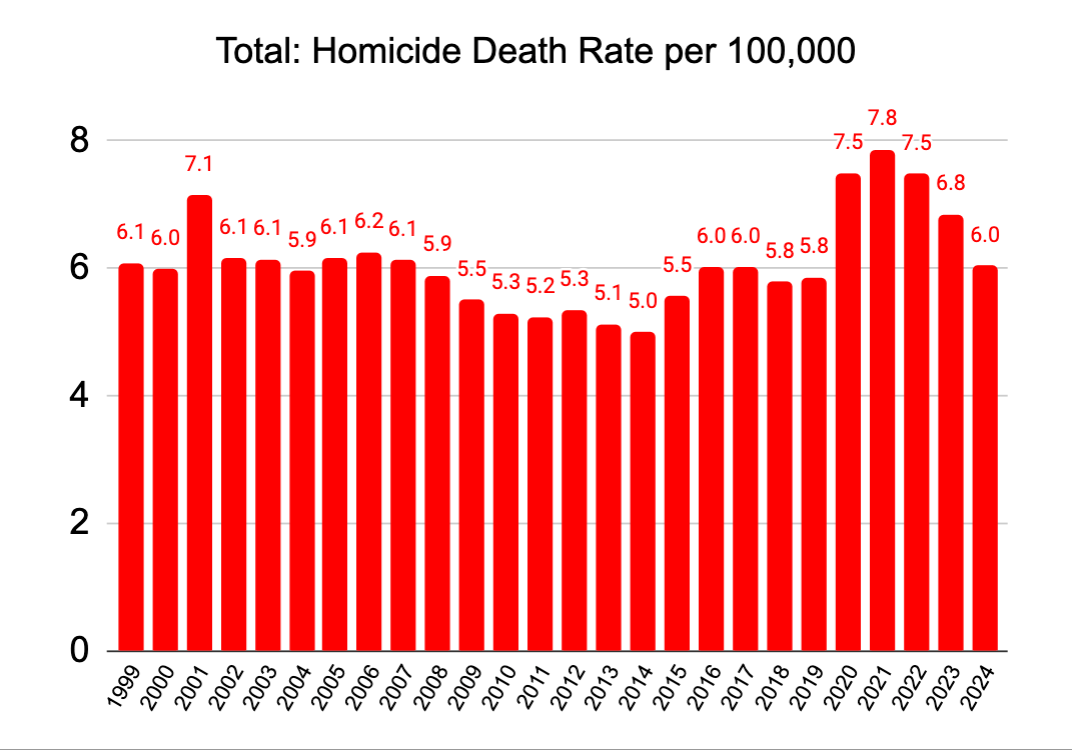CDC: Black Homicide Rate Still Up 28% Since Dawn of BLM Era
The overall homicide rate for all races dropped sharply in 2024, but is still up 21% overall since Ferguson.
The CDC has finally released its homicide victimization death counts for 2024. (It lags release of death data for potentially legally fraught categories like homicides, suicides, and motor vehicle accidents by 6 months to give coroners plenty of time to make up their minds.)
Matthew Yglesias frames the recent data as good news, which it is:
30 months of great news on falling crime
Things are getting way better, but some big unanswered questions remain
Matthew Yglesias
Jul 10, 2025
∙ Paid
Homicides and non-fatal shootings soared in 2020. The level was still below the worst period of American crime, but the uptick represented the fastest increase in violence on record. The trend continued in 2021, albeit at a reduced pace, and I was worried during the winter of 2021-2022 that it might take a really long time to get things back under control. But as the summer of 2025 gets underway, the news seems good: Violence fell a little in 2022, and then a lot in 2023 and 2024. And while trends vary somewhat from place to place, the overall trend this year continues to be positive.
Jeff Asher wrote back in May that 2025 was on pace to be perhaps the lowest murder rate year on record. But even if we fall short of that milestone, we’ll be within spitting distance.
On the other hand, the homicide death rate for the total U.S. population was still 21% higher in 2024 than in 2014, when the Black Lives Matter movement emerged in August 2014 with Ferguson, and 0.2% worse than in 2019 before George Floyd’s May 2020 death launched the disastrous Racial Reckoning:
(Note that the high homicide death rate in 2001 was due to 9/11.)
Black fatalities due to homicides were 28% higher last year than before BLM got rolling, but at least are finally back down to where they were in 2019.
The Hispanic homicide death rate fell dramatically from the Housing Bubble to 2014, but is now up 22% over the last decade and 12% since 2019.
The white homicide rate is up 6% since 2014, but down 2% since 2019.
The Asian rate is down 18% since 2014 and down 14% since 2019.
I didn’t do a graph of American Indians, but they are not doing well: homicides are up 42% since 2014 and up 9% since 2019.
Here are the lines for all the races except Native Americans:








I'm still trying to get attention for what I've branded "The American Slaughter" -- 150,000 dead young black males in the USA just since 1995. That's 5,000 dead black young men a year, at least, predominantly killed by other young black males, usually with handguns. It's an ongoing national tragedy that black leaders and important big media both don't seem to know about or are too chicken to raise it as an issue and address its causes and cures. https://clips.substack.com/p/american-slaughter-july-4th-edition
I too am glad there is less murder and mayhem lately, but, as usual, Yglesias's Pollyannaism is unwarranted.
Just as we use a GDP deflator ("inflation") to correct GDP statistics so we can see the underlying value, we also need a Homicide Deflator to apply to homicide statistics so we can see the underlying level of social dysfunction, which is usually what people actually want to know when they look up homicide stats. One homicide today might be the moral/social equivalent of two homicides a couple of decades ago, when emergency response was slower and trauma surgery less capable, for example.
So when Yglesias says, "Hooray, we're approaching the lowest murder rate year on record," he's wrong, first of all because he's suffering from a bad case of present-tense-ism (murder rates were much lower before the Great Liberalization began in the 1960s), but second because even if we only look at the 21st century, a murder today is societally more significant than a murder ten or twenty years ago because society has taken more steps prevent or mitigate assaults since ten or twenty years ago.
Trauma care has improved steadily over the last few decades. More widespread car ownership and transport options made trips to the hospital faster. Ubiquitous cell phones have made emergency response faster. And ubiquitous surveillance cameras and cell net monitoring have almost certainly suppressed some crime that would formerly have occurred.
If we had data for non-fatal shootings, it would be possible to create a relatively objective Homicide Deflator by dividing fatal gunshot wounds by non-fatal gunshot wounds. Unfortunately, no dataset of non-fatal shootings exists in the US, AFAIK. Maybe one of the better run European countries has such data?